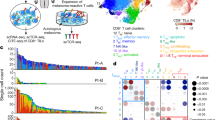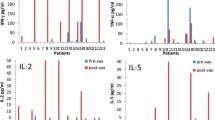Abstract
Treatment of metastatic melanoma patients with an autologous vaccine modified by the hapten, dinitrophenyl (DNP), produces a striking immunological effect: the induction of clinically evident inflammatory responses in metastatic tumors. Histological examination shows these tumors to be infiltrated with T lymphocytes. We studied the expression of activation markers on those cells and compared them with matched peripheral blood lymphocytes (PBL) and with lymphocytes extracted from metastases before treatment with DNP-conjugated vaccine. The median fraction of cells that were T cells in post-vaccine tumors was 41%, as compared with 9% in pre-treatment tumors, and those T cells were predominantly CD8+ (mean CD8/CD4 ratio=5.0). A high proportion of both pre- and posttreatment infiltrating T cells expressed HLA-DR (mean±SE=48%±4%), CD69 (56%±7%), and ganglioside GD3 (68%±5%). This distinguished them from matched PBL in which expression of those markers was significantly lower (HLA-DR=10%±2%; CD69=2%±0.4%; GD3=49%±4%). These changes were not accompanied by increased cell-surface expression of interleukin-2 (IL-2) receptors, either CD25 or p75, which were expressed by 1%–2% and 12% of tumor-infiltrating lymphocytes (TIL), respectively. The pattern of activation marker expression that we identified appears to be characteristic of tissue T cells with the memory phenotype. The low expression of IL-2 receptors could indicate functional impairment of TIL in situ, perhaps because of inhibitory molecules produced by melanoma cells.
Similar content being viewed by others
References
Alexander JP, Kudoh S, Melsop KA, Hamilton TA, Edinger MG, Tubbs RR, Sica D, Tuason L, Klein E, Bukowski RM, Finke JH (1993) T-cells infiltrating renal cell carcinoma display a poor proliferative response even though they can produce interleukin 2 and express interleukin 2 receptors. Cancer Res 53: 1380
Anichini A, Fossati G, Parmiani G (1987) Clonal analysis of the cytolytic T-cell response to human tumors. Immunol Today 8: 385
Berd D, Maguire HC Jr, Mastrangelo MJ (1986) Induction of cell-mediated immunity to autologous melanoma cells and regression of metastases after treatment with a melanoma cell vaccine preceded by cyclophosphamide. Cancer Res 46: 2572
Berd D, Murphy G, Maguire HC Jr, Mastrangelo MJ (1991) Immunization with haptenized, autologous tumor cells induces inflammation of human melanoma metastases. Cancer Res 51: 2731
Berd D, Maguire HC Jr, Mastrangelo MJ (1993) Treatment of human melanoma with a hapten-modified autologous vaccine. Ann NY Acad Sci 690: 147
Cantrell DA, Smith KA (1983) Transient expression of interleukin 2 receptors. J Exp Med 158: 1895
Cardi G, Mastrangelo, MJ, Berd D (1989) Depletion of T-cells with the CD4-CD45R+ phenotype in lymphocytes that infiltrate subcutaneous metastases of human melanoma. Cancer Res 49: 6562
Cohen PJ, Lotze MT, Roberts JR, Rosenberg SA, Jaffe ES (1987) The immunopathology of sequential tumor biopsies in patients treated with interleukin-2. Correlation of response with T-cell infiltration and HLA-DR expression. Am J Pathol 129: 208
Cotner T, Williams JM, Christenson L, Shapiro HM, Strom TB, Strominger JL (1983) Simultaneous flow cytometric analysis of human T cell activation antigen expression and DNA content. J Exp Med 157: 461
Elder DE, Ainsworth AM, Clark WH Jr (1979) The surgical pathology of cutaneous malignant melanoma. In: Clark WH Jr, Goldman LI, Mastrangelo MJ (eds) Human malignant melanoma. Grune and Stratton, New York, pp 100
Evans R, Faldetta TJ, Humphreys RE, Pratt DM, Yunis EJ, Schlossman SF (1978) Peripheral human T cells sensitized in mixed leukocyte culture synthesize and express Ia-like antigens. J Exp Med 148: 1440
Finke JH, Zea AH, Stanley J, Longo DL, Mizoguchi H, Tubbs RR, Wiltrout RH, O'Shea JJ, Kudoh S, Klein E, Bukowski RM, Ochoa AC (1993) Loss of T-cell receptor zeta chain and p56lck in T-cells infiltrating human renal cell carcinoma. Cancer Res 53: 5613
Hersey P, Jamal O (1989) Expression of the gangliosides GD3 and GD2 on lymphocytes in tissue sections of melanoma. Pathology 21: 51
Hersey P, Schibeci SD, Townsend P, Bruns C, Cheresh DA (1986) Potentiation of lymphocyte responses by monoclonal antibodies to the ganglioside GD3. Cancer Res 46: 6083
Lewis RE, Buchsbaum M, Whitaker D, Murphy GF (1989) Intercellular adhesion molecule expression in the evolving human cutaneous delayed hypersensitivity reaction. J Invest Dermatol 93: 672
Miller SD, Claman HN (1976) The induction of hapten-specific T cell tolerance by using hapten modified lymphoid cells. I Characteristics of tolerance induction. J Immunol 117: 1519
Murphy GF, Radu A, Kaminer M, Berd D (1993) Autologous melanoma vaccine induces inflammatory responses in melanoma metastases: Relevance to immunologic regression and immunotherapy. J Invest Dermatol 100: 335S
Picker LJ, Treer JR, Ferguson-Darnell B, Collins PA, Bergstresser PR, Terstappen LWMM (1993) Control of lymphocyte recirculation in man. II. Differential regulation of the cutaneous lymphocyte-associated antigen, a tissue-selective homing receptor for skin-homing T cells. J Immunol 150: 1122
Picker LJ, Treer JR, Ferguson-Darnell B, Collins PA, Buck D, Terstappen LWMM (1993) Control of lymphocyte recirculation in man. I. Differential regulation of the peripheral lymph node homing receptor L-selectin on T cells during the virgin to memory cell transition. J Immunol 150: 1105
Rosenberg SA, Packard BS, Aebersold PM, Solomon D, Topalian, SL, Toy ST, Simon P, Lotze MT, Yang JC, Seipp CA, Simpson C (1988) Use of tumor-infiltrating lymphocytes and interleukin-2 in the immunotherapy of patients with metastatic melanoma. A preliminary report. N Engl J Med 319: 1676
Testi R, Phillips JH, Lanier LL (1989) Leu23 induction as an early marker of functional CD3/T cell antigen receptor triggering: requirement for receptor crosslinking, prolonged elevation of intracellular Ca2+ and activation of PKC. J Immunol 142: 1854
Welte K, Miller G, Chapman PB, Yuasa H, Natoli E, Kunicka JE, Cordon-Cardo C, Buhrer C, Old LJ, Houghton AN (1987) Stimulation of T lymphocyte proliferation by monoclonal antibodies against GD3 gangliosides. J Immunol 139: 1763
Author information
Authors and Affiliations
Additional information
This work was supported by NIH grants CA 39248, CA 40358, and AR 39674 from the National Institutes of Health and by funds from the Nat Pincus Trust
Rights and permissions
About this article
Cite this article
Berd, D., Maguire, H.C., Mastrangelo, M.J. et al. Activation markers on T cells infiltrating melanoma metastases after therapy with dinitrophenyl-conjugated vaccine. Cancer Immunol Immunother 39, 141–147 (1994). https://doi.org/10.1007/BF01533378
Received:
Issue Date:
DOI: https://doi.org/10.1007/BF01533378




